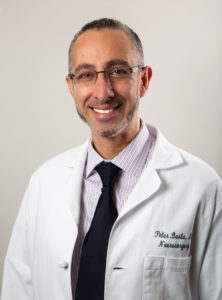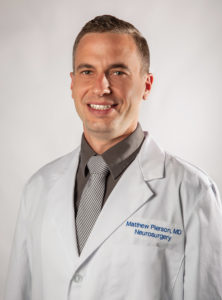Request an Appointment
Please call our office at 816-363-2500 to make an appointment. Don’t forget to bring your imaging studies with you.
Aneurysm Treatment
A cerebral aneurysm (also known as a brain aneurysm) is a swelling or bulging involving one of the arteries inside the head. The artery has a focal area of weakening that results in the formation in one of these aneurysms. Once an aneurysm has formed, there is a risk of rupture or bleeding. This can lead to significant illness. Once identified, there are a variety of treatment options available. At Midwest Neurosurgery Associates, our neurosurgeons treat cerebral aneurysms on a daily basis and in a variety of ways based on each individual patient. Please consider coming to see us for a consultation to find out more.
Craniotomy to Treat Aneurysms: Patients suffering from conditions within the skull, like aneurysms, require a craniotomy.
Not all aneurysms require immediate treatment. Very small (less than 3 mm) aneurysms are less likely to break or rupture; thus, may not need immediate treatment.
A surgeon may decide to treat an aneurysm, even when it does not show any symptoms, in order to prevent the possibility of a fatal rupture in the future. Surgery may involve coiling or clipping and is used to treat both ruptured and unruptured aneurysms. This is one of the most commonly used methods for repairing aneurysms.
Surgical clipping is performed through a craniotomy. A craniotomy is a surgical procedure that allows access to the brain and blood vessels inside the head via an opening in the skull. Once the aneurysm itself is clearly identified, a small metal clip is applied to it. This eliminates the risk of this an aneurysm from bleeding in the future.
Endovascular surgery often uses a “coil” or coiling to repair aneurysms. This is a less invasive way to treat certain aneurysms.
What You Need to Know About Aneurysms
The symptoms of aneurysms depend on whether they are ruptured or unruptured.
Patients suffering from a ruptured cerebral aneurysm may exhibit symptoms such as:
- Headaches and localized migraines
- Nausea
- Stiffness in neck
- Problems with vision (e.g., blurry or double vision)
- Sensitivity to light (i.e., photophobia)
- Loss of sensation
- Vomiting
Most of patients with unruptured cerebral aneurysms do not show any symptoms. Others might exhibit some or all of the following:
- Cranial nerve palsy
- Double vision
- Sudden severe headache
- Numbness in any part of body
- Dilated pupils
- Pain above and behind eye
- Progressive weakness
- Neck pain
Hospitalization Time
1 to 2 days
Downtime
1 to 2 weeks
Diagnosis
The following are used to diagnose aneurysms:
- Cerebral Angiography: A dye is injected into the blood and x-rays of the brain are taken. Cerebral angiography helps to detect the location and size of aneurysms and vascular malformations.
- Computed Tomographic Angiography (CTA): A dye is injected into the blood and we obtain images of the brain via a CT scan.
- Computed Tomography (CT) Scan: X-rays are taken, the data is fed to a computer and then a computer-generate image is created. CT scans are usually a more useful test for hemorrhagic strokes because the blood can be easily seen.
- Doppler Ultrasound: High-frequency sound waves are used to detect abnormalities in the veins.
- Magnetic Resonance Angiogram (MRA): The images of the brain’s arteries will reveal both aneurysms and blockages of the arteries.
Meet Your Surgeon
Meet with your surgeon, who will look at your studies and discuss with you the best aneurysm treatment.
Watchful Waiting
Depending on the findings, your doctor may suggest “watchful waiting” with MRIs, a coiling procedure, or intracranial surgery with clipping of the aneurysm..
Scheduling
If coiling or intracranial surgery is recommended, we will schedule your admission to the hospital.
Recuperation
Recuperation from surgery will take 3 to 6 weeks or longer.
This material is intended to give the patient an overview of surgical procedures and treatments and is not intended to replace the advice and guidance of a physician. Always consult with your doctor about the particular risks and benefits of your treatment.



 The Highest Quality of Neurosurgical Care
The Highest Quality of Neurosurgical Care